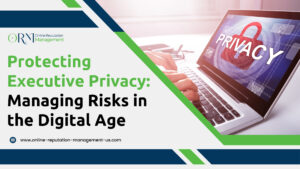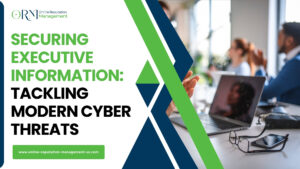Executives face significant risks in a digital world where sensitive personal and corporate information is often just a few clicks away. Due to their high visibility, financial power, and access to critical company networks, executives are prime targets for identity theft, data breaches, and even physical harm. Reputation management firms are crucial in mitigating these risks by helping executives monitor and protect their personal information online. This article explores how sensitive information is compromised, the risks executives face, and practical steps to safeguard their privacy.
Risks of Leaked Personal Information
When personal data is exposed, the consequences can be severe:
- Financial Loss: Cybercriminals can exploit leaked financial data to steal money or assets.
- Compromised Safety: Publicly available personal details can lead to stalking, harassment, or worse.
- Reputational Damage: Information leaks can tarnish an executive’s public image, leading to scrutiny or impersonation.

Effective online reputation management (ORM) is essential. Orm service can help executives protect their privacy and maintain safety by:
- Removing personally identifiable information from online databases.
- Identifying and requesting the removal of sensitive data from search results and data broker sites.
- Advising on building a professional online presence without exposing personal identifiers.
Common Privacy Breaches
Executives are at heightened risk of privacy breaches, which include:
- Data Leaks: Cybercriminals may hack corporate systems or third-party vendors, exposing sensitive personal and company data.
- Doxxing: The public release of personal information, such as addresses or phone numbers, can lead to harassment or physical threats.
- Deepfakes: Advanced technology enables threat actors to manipulate audio or video, impersonating executives to damage reputations or exploit sensitive information.
- Social Media Scams: Fake profiles impersonating executives can scam others or tarnish reputations.
- Internet of Things (IoT) Vulnerabilities: Smart devices create new opportunities for cyberattacks, exposing personal and corporate data.
Rising Cyber Threats: Extortion and Ransomware
Cyber extortion is a growing concern, where hackers demand payment to prevent the release of sensitive data. A common tactic is ransomware, malicious software that encrypts data until a ransom is paid. While ransomware attacks have declined slightly, other extortion methods are increasing.
Personal Safety Risks
Beyond cyber risks, executives face real-world threats, including:
- Harassment and Stalking: Cybercriminals can track executives’ movements online and offline.
- Home Invasion: Publicly available addresses increase the risk of burglary or robbery.
- Kidnapping: Executives or their families may be abducted for ransom or leverage.
- Physical Assault: Public controversies or workplace disputes can escalate into violence.
- Event Risks: Known public appearance schedules heighten violence risks at events.
The overlap between cyber and physical threats makes personal safety a critical concern for executives.
Tips to Protect Executive Privacy
To mitigate risks, executives can take these steps:
- Limit Online Exposure: Use privacy settings on social media and avoid sharing sensitive details publicly.
- Remove Data from People Search Sites: Request to remove information from data broker platforms.
- Strengthen Cybersecurity: Implement robust personal and corporate cybersecurity measures, including multi-factor authentication.
- Hire ORM Experts: Professionals can proactively monitor and manage online reputations.
- Secure IoT Devices: Regularly update and protect smart devices.
- Educate Employees: Training on best practices for privacy reduces internal breaches.


FAQs:
Q1. Why are executives more vulnerable to privacy breaches compared to others?
Executives have high visibility, financial power, and top-tier access to sensitive company information, making them prime targets for cybercriminals seeking financial gain or corporate leverage.
Q2. How does leaked personal information put an executive at risk?
Leaked information can lead to financial loss, identity theft, reputational damage, and even physical risks such as stalking, harassment, or home invasion.
Q3. What are some common sources of leaked executive information?
Key sources include people-search sites, social media profiles, public databases, and corporate or personal cybersecurity systems vulnerabilities.
Q4. What practical steps can executives take to protect their personal information?
- Remove personal information from people-search databases.
- Limit personal details shared on social media.
- Use secure passwords and enable multi-factor authentication.
- Regularly monitor online presence for unauthorized data leaks or impersonations.
Q5. What role does Online Reputation Management (ORM) play in executive privacy?
Orm service helps mitigate privacy risks by removing sensitive information from online databases, monitoring for data breaches, and ensuring that personal and professional profiles are free from compromising details.
Conclusion
Executives are uniquely vulnerable in today’s interconnected world. Financial power, high visibility, and access to critical data make them attractive targets for cybercriminals and other bad actors. Partnering with the best reputation management companies can help executives proactively safeguard sensitive information and personal safety, mitigating risks and enabling them to navigate the digital world more securely.





